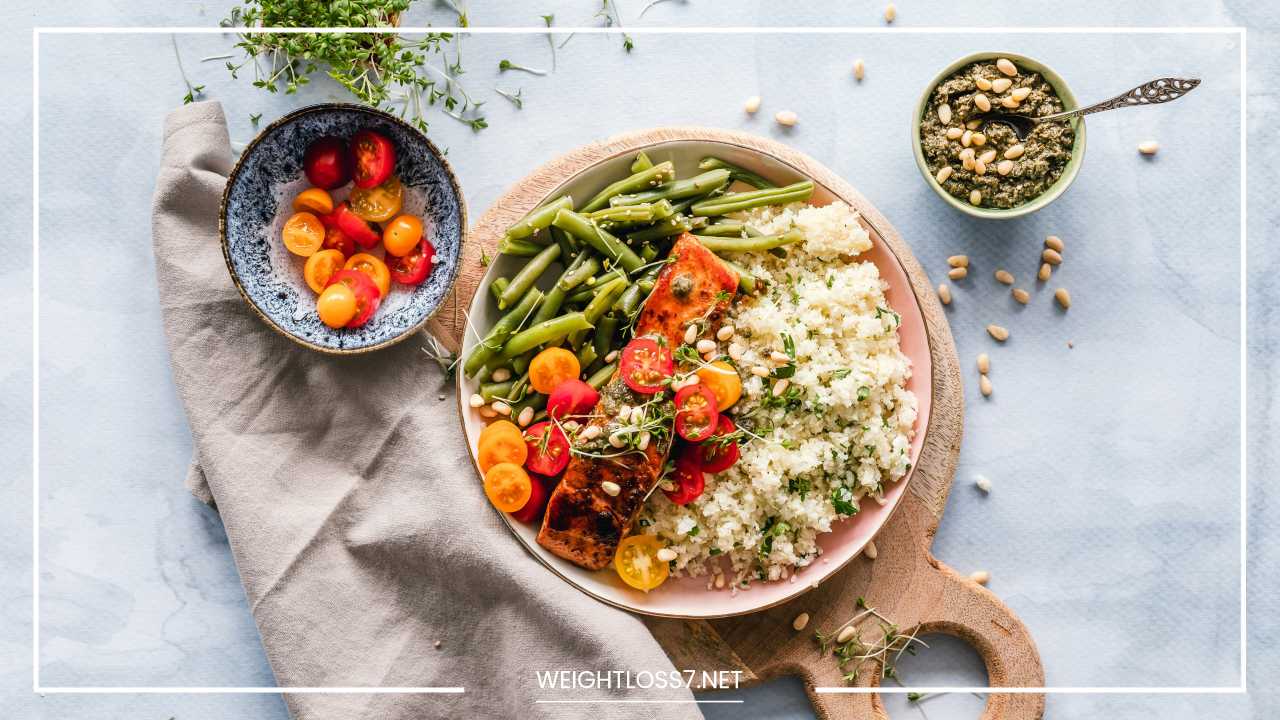Healthy Eating Recipes for Weight Loss

Healthy Eating Recipes
Healthy Eating Recipes for Weight Loss: Delicious Meals to Fuel Your Journey
Shedding pounds doesn’t have to mean sacrificing flavor or variety in your diet. In fact, incorporating healthy and delicious recipes into your weight loss plan is key to staying motivated and reaching your goals.
This blog post is your guide to a world of flavorful, nutritious meals that will keep you feeling satisfied and energized throughout your weight loss journey.
Why Focus on Healthy Eating for Weight Loss?
While calorie restriction plays a role in weight loss, it’s not the whole picture. Focusing solely on restricting calories can leave you feeling deprived and lead to unhealthy eating habits in the long run.
Healthy eating, on the other hand, provides your body with the essential nutrients it needs to function optimally.
This translates to increased energy levels, improved mood, and a stronger metabolism, all of which contribute to successful weight loss.
Recipe Strategies for Weight Loss Success
Here are some key strategies to keep in mind when choosing recipes for weight loss:
-
Focus on Whole Foods: Prioritize whole, unprocessed foods like fruits, vegetables, lean proteins, and whole grains. These foods are naturally lower in calories and packed with nutrients that keep you feeling full. Some great examples include:
- Fruits: Berries, citrus fruits, apples, pears, melons
- Vegetables: Leafy greens (spinach, kale), broccoli, asparagus, bell peppers, carrots, sweet potatoes
- Lean Proteins: Chicken breast, fish (salmon, tuna), beans and lentils, tofu, low-fat Greek yogurt
- Whole Grains: Brown rice, quinoa, whole-wheat bread, oats
-
Portion Control: Pay attention to portion sizes. Even healthy foods can contribute to weight gain if consumed in excess. Use measuring cups and spoons, or visually estimate portions based on the size of your palm or fist. Here’s a helpful guide:
- Protein: 3-4 ounces (about the size of a deck of cards)
- Grains: ½ cup cooked (about the size of a tennis ball)
- Vegetables: 1 cup raw or ½ cup cooked (about the size of your fist)
- Fruits: 1 medium-sized piece or ½ cup chopped (about the size of a baseball)
-
Low-Fat Cooking Methods: Opt for cooking methods like grilling, baking, roasting, and steaming to minimize added fat. These methods bring out the natural flavors of your ingredients without adding unnecessary calories. Here are some additional tips for healthy cooking:
- Use nonstick cooking spray or a minimal amount of olive oil to prevent sticking.
- Marinate meats and vegetables to infuse them with flavor and reduce the need for added fat during cooking.
- Drain excess fat from cooked meats before serving.
-
Spice it Up!: Spices and herbs add depth of flavor to your dishes without adding calories. Experiment with different spices to create exciting flavor profiles that keep your taste buds happy. Some flavorful options include:
- Garlic powder
- Onion powder
- Chili powder
- Cumin
- Oregano
- Basil
- Thyme
- Cilantro
Breakfast Recipes to Kickstart Your Day
Getting your day started with a nutritious breakfast sets the tone for healthy eating throughout the day. Here are some delicious and filling breakfast recipe ideas:
-
High-Protein Scrambled Eggs with Vegetables: Scramble eggs with chopped vegetables like spinach, peppers, and onions for a protein-packed breakfast that keeps you feeling full until lunchtime. Here are some variations to keep your taste buds interested:
- Mediterranean Scramble: Add crumbled feta cheese, sun-dried tomatoes, and chopped olives for a flavorful twist.
- Southwestern Scramble: Spice things up with diced tomatoes, green chiles, and a sprinkle of chili powder.
-
Overnight Oats: Combine rolled oats with Greek yogurt, chia seeds, and your favorite fruits for a delicious and nutritious breakfast that requires minimal prep work. Here are some customization ideas:
- Berry Blast: Mix in blueberries, raspberries, and a drizzle of honey for a burst of sweetness and antioxidants.
- Tropical Twist: Add chopped mango, pineapple, and a sprinkle of shredded coconut for a taste of the tropics.
-
Whole-Wheat Pancakes with Berries: Make fluffy whole-wheat pancakes and top them with fresh berries like blueberries or raspberries for a satisfying and antioxidant-rich breakfast. For added protein, you can:
- Add a scoop of protein powder to the pancake batter.
- Serve the pancakes with a dollop of low-fat ricotta cheese or cottage cheese.
Lunch Recipes for Work or Home
Lunchtime can be a challenge when it comes to healthy eating, especially if you’re busy at work. Here are some quick and easy lunchbox staples that you can prepare in advance or assemble in a flash:
- Leftovers: Don’t underestimate the power of leftovers! Leftovers from a healthy dinner can be a lifesaver for a quick and nutritious lunch.
- Mason Jar Salads: Layer prepped salad ingredients like chopped vegetables, cooked grains like quinoa or brown rice, and lean protein like grilled chicken or tofu in a mason jar. When lunchtime arrives, simply add your dressing and shake for a fresh and flavorful salad.
- Wraps and Roll-Ups: Whole-wheat tortillas or wraps are a versatile lunch option. Fill them with hummus and roasted vegetables, grilled chicken or turkey breast with lettuce and tomato, or almond butter and sliced banana for a sweet twist.
- Soup and Salad Combo: Pack a container of leftover soup or whip up a quick and easy vegetable soup. Pair it with a side salad for a light and satisfying lunch.
- Tuna or Chicken Salad: Prepare a batch of tuna or chicken salad with light mayonnaise, chopped celery, red onion, and your favorite herbs and spices. Serve on whole-wheat bread or crackers for a protein-packed lunch.
- Hard-Boiled Eggs with Veggies and Dip: Hard-boiled eggs are a great source of protein and portable for lunch. Pair them with chopped vegetables like baby carrots, cherry tomatoes, and bell pepper slices for dipping in hummus or Greek yogurt.
-
Quinoa Salad with Grilled Chicken: Combine cooked quinoa with grilled chicken breast, chopped vegetables like chopped bell peppers, cherry tomatoes, and crumbled feta cheese for a protein- and fiber-rich lunch salad. Dress with a light vinaigrette for added flavor.
-
Lentil Soup: Whip up a hearty lentil soup packed with vegetables and lean protein. This soup is not only filling but also affordable and easy to make in large batches for meal prepping. Here are some variations to add variety:
- Italian Lentil Soup: Sauté chopped onions, carrots, and celery in olive oil. Add lentils, diced tomatoes, canned diced tomatoes with basil, vegetable broth, and Italian seasoning. Simmer until lentils are tender.
- Curried Lentil Soup: Sauté onions, garlic, and ginger in olive oil. Add curry powder, lentils, vegetable broth, and chopped vegetables like carrots and potatoes. Simmer until lentils are tender and finish with a swirl of coconut milk for a creamy texture.
-
Black Bean Burgers: Skip the greasy fast-food burgers and opt for homemade black bean burgers. These burgers are packed with protein and fiber and can be enjoyed on whole-wheat buns with your favorite toppings. Here are some ideas to customize your black bean burgers:
- Spicy Black Bean Burgers: Add chopped jalapenos, red onion, and a pinch of cayenne pepper to the burger mixture for a kick.
- Southwestern Black Bean Burgers: Mix in corn, black beans, chopped bell peppers, and a sprinkle of chili powder for a southwestern twist.
Dinner Recipes to Impress and Nourish
Dinner is a great time to get creative and explore new flavors. Here are some healthy and satisfying dinner recipe ideas:
-
Salmon with Roasted Vegetables: Salmon is a fantastic source of lean protein and healthy fats. Bake salmon fillets with your favorite roasted vegetables like broccoli, asparagus, or Brussels sprouts for a balanced and flavorful meal. Here are some additional tips for a delicious salmon dish:
- Marinate the salmon in a mixture of olive oil, lemon juice, fresh herbs like dill or parsley, and a pinch of garlic powder for added flavor.
- Toss the vegetables with olive oil, salt, pepper, and a sprinkle of your favorite spices like paprika or Italian seasoning before roasting.
-
Turkey Chili: This classic chili recipe can be made healthier by using lean ground turkey and loading it up with vegetables like kidney beans, black beans, corn, tomatoes, and chopped bell peppers. Here are some ways to customize your turkey chili:
- White Bean Turkey Chili: Substitute cannellini beans or white kidney beans for a lighter-colored chili.
- Slow Cooker Turkey Chili: Throw all the ingredients for the chili in a slow cooker and let it simmer for a few hours for a hands-off approach.
-
Chicken Stir-Fry with Brown Rice: Whip up a quick and easy stir-fry with lean chicken strips, colorful vegetables like bell peppers and snow peas, and a low-sodium soy sauce-based stir-fry sauce. Serve over brown rice for added fiber. Here are some tips for a flavorful stir-fry:
- Use a variety of colorful vegetables for added nutrients and visual appeal.
- Thicken your stir-fry sauce with a cornstarch slurry for a glossy finish.
- Serve with a sprinkle of sesame seeds or chopped peanuts for extra crunch.
Snacking Smart for Weight Loss
Healthy snacking can help curb cravings and prevent overeating at mealtimes. Here are some healthy and satisfying snack ideas, along with some portion control tips:
-
Fruits with Nut Butter: Pair apple slices, pear slices, or celery sticks with almond butter or peanut butter for a protein and fiber-rich snack. Limit yourself to a serving size of about 2 tablespoons of nut butter and a single piece of fruit or a few celery sticks.
-
Greek Yogurt with Berries: Greek yogurt is a great source of protein and calcium. Top it with your favorite berries like blueberries or raspberries and a sprinkle of granola for a delicious and nutritious snack. Opt for plain Greek yogurt and add your own fruit and sweetener to control the sugar content. A single serving size is typically around 6 ounces of Greek yogurt and ¼ cup of berries.
-
Veggie Sticks with Hummus: Dip carrot sticks, cucumber slices, or bell pepper strips into hummus for a healthy and satisfying snack that’s packed with fiber and protein. Aim for a portion size of about ½ cup of chopped vegetables and 2-3 tablespoons of hummus.
-
Hard-boiled Eggs: Hard-boiled eggs are a convenient and portable protein-rich snack. Limit yourself to 1-2 eggs at a time.
-
Edamame: Edamame are young soybeans that are a great source of plant-based protein and fiber. They come pre-cooked and frozen in the pod, making them a convenient and healthy snack. Stick to a serving size of about ½ cup of shelled edamame.
-
Trail Mix: Make your own trail mix for a customizable and satisfying snack. Combine nuts like almonds, cashews, and peanuts with dried fruits like cranberries, raisins, and chopped dates. Add a sprinkle of dark chocolate chips for a touch of indulgence. Limit yourself to a ¼ cup serving size to avoid overdoing it on calories.
Remember, Consistency is Key
Developing healthy eating habits takes time and consistency. Don’t get discouraged if you slip up occasionally. The key is to get back on track with your healthy eating plan and enjoy the delicious and nutritious meals that fuel your weight loss journey. Here are some additional tips to help you stay on track:
-
Plan Your Meals: Planning your meals for the week can help you make healthy choices and avoid unhealthy temptations when hunger strikes. Here’s how to get started:
- Dedicate some time each week to browse recipes and create a meal plan.
- Make a grocery list based on your chosen recipes.
- Consider prepping some meals or ingredients in advance to save time during the week.
-
Drink Plenty of Water: Water is essential for overall health and can also help you feel full, reducing calorie intake. Aim to drink eight glasses of water daily. Here are some tips to increase your water intake:
- Carry a reusable water bottle with you throughout the day.
- Add a squeeze of lemon, lime, or cucumber to your water for a refreshing twist.
- Drink a glass of water before each meal to help you feel full.
-
Find an Exercise Routine You Enjoy: Regular exercise is a crucial part of any weight loss plan. Find an activity you enjoy, whether it’s walking, running, swimming, dancing, or cycling. Aim for at least 30 minutes of moderate-intensity exercise most days of the week.
-
Don’t Deprive Yourself: Restrictive diets are often unsustainable and can lead to binge eating. Allow yourself occasional treats in moderation. The key is to find a healthy balance that you can stick with in the long run.
-
Celebrate Your Successes: Track your progress and celebrate your achievements along the way. This will help you stay motivated and on track with your weight loss journey.
Final Word
Making healthy changes to your diet doesn’t have to be bland or boring. With a little creativity and planning, you can enjoy delicious and nutritious meals that support your weight loss goals.
Remember, consistency is key. By incorporating these tips and recipes into your daily routine, you can achieve your weight loss goals and feel your best!

















